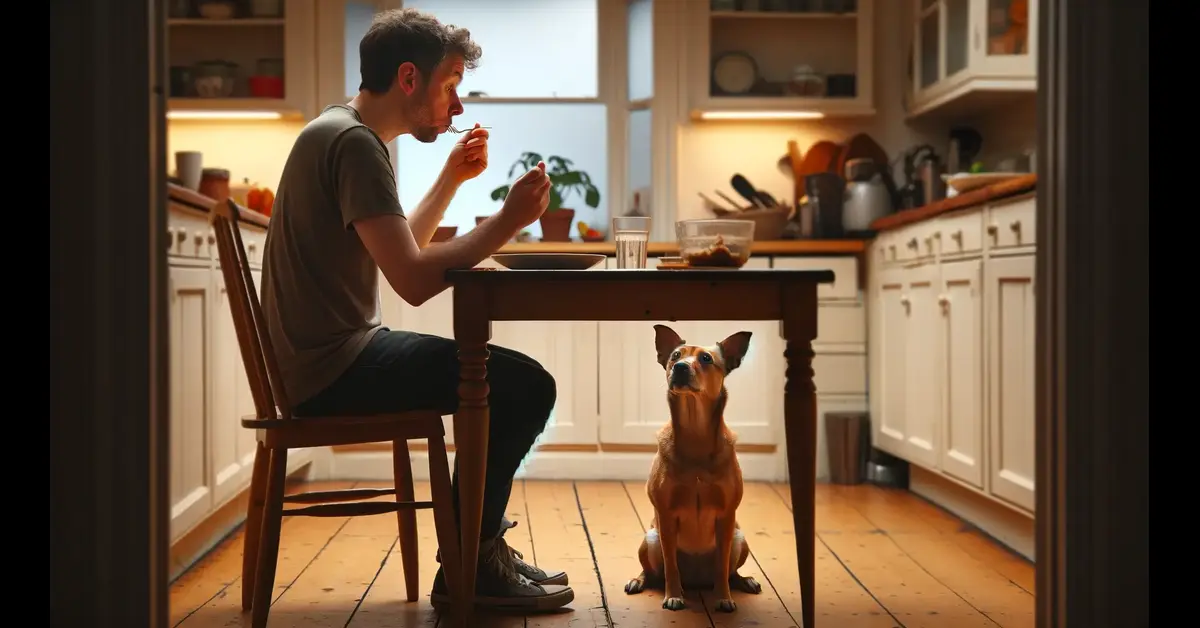Deciphering the Woofs: Unraveling Why Your Dog Barks During Your Meals
Introduction
Welcome to WaggyWave, where we dive tail-first into the heart of dog ownership and the quirky behaviors of our canine companions. Have you ever wondered, “Why does my dog bark when I eat?” You’re not alone. This question puzzles many dog owners as they try to enjoy a peaceful meal, only to be met with their pup’s persistent barking. It’s a scenario that can turn the simple act of eating into a noisy ordeal. But fear not, because understanding the “why” behind those barks is the first step toward finding harmony at the dinner table.
In this guide, we’ll explore the various reasons your furry friend feels the need to vocalize during your meal times. From a cry for attention to an expression of discomfort, dogs communicate in ways that aren’t always clear to us. We’ll unpack these motives, looking at everything from demand barking to the stress that might be leading to this loud behavior. By getting to the root of why your dog barks when you eat, we can start to address their needs more effectively.
But we won’t stop there. Recognizing why your dog is barking is just the beginning. We’ll also share tailored strategies to help ensure that both you and your pooch can enjoy your meals in peace. Whether it’s through training, dietary adjustments, or setting up a distraction-free zone, we’re here to guide you through making mealtime a quiet, enjoyable experience for everyone involved. So, grab your fork, and let’s dig in to turn those bothersome barks into contented silence.
Spotting the Telltale Signs: Identifying Concerning Barks at Mealtime
When your dog starts barking nonstop as you sit down to eat, it’s more than just a small annoyance. This behavior can disrupt the peace of your mealtime. It’s important to pay attention to this, as it might be your dog’s way of saying they need something. Whether it’s the loud, demanding barks for a bite of your dinner or a softer whimper hoping for some attention, understanding these signs is the first step in addressing the issue.
Unpacking the Whys: Exploring the Motives Behind Your Dog’s Barks
Understanding why your dog decides to hold a barking concert while you’re eating is crucial to solving this noisy puzzle. Dogs communicate through barks, and during meal times, these sounds are their way of telling you something. Whether it’s a plea for a piece of your dinner or an expression of feeling left out, recognizing these reasons is the first step towards a quieter dining experience. Let’s explore the common triggers for these mealtime performances and how you can address them.
A Call for Attention and Treats
Imagine sitting at the dinner table, enjoying your food, and noticing your pup’s eyes fixed on you, feeling left out. It’s in a dog’s nature to crave attention and interaction. Watching you eat, they might worry they’re being overlooked, sparking a sense of exclusion. This feeling can quickly turn into demand barking, their vocal way of pulling your focus back to them with a loud “Look at me!” or an eager “I want some too!”
To address this, occasionally giving your dog a bit of healthy dog food or a special treat during your meals might seem like a kind gesture. However, it’s crucial to maintain a balance. Frequent treats, especially human food, could be harmful to their health. The aim is to appreciate and reinforce your dog’s good behavior without inadvertently promoting unwanted actions like barking for your attention during mealtime.
Learned Responses: The Making of a Mealtime Barker
Dogs are smart. They remember what actions get them what they want. If once, just once, your dog got a tasty bit from your plate for barking, they’ve likely learned to repeat that behavior. This cause-and-effect learning is strong in dogs. They think, “If I bark, I might get something delicious.” It’s crucial to stop your dog from barking for food by not giving in. Instead, train your dog to go to another room or their crate during meal times. This way, they learn that quiet behavior during your meals is what gets them a reward later.
Restlessness and Stress: Understanding the Underlying Emotions
Sometimes, your dog’s barking isn’t about wanting food from your plate. They might be barking out of boredom, anxiety, or stress. When dogs don’t get enough play or exercise, they can feel restless. They need activities to keep their minds and bodies busy. If they’re bored or anxious, they might start barking at meal times. It’s a way for them to express their feelings. To help them, ensure they have plenty of time to play and go on walks. Toys can also keep them busy. A tired dog usually barks less.
It’s also important to look at where your dog eats and spends time. They need a quiet and safe spot to enjoy their meals without feeling stressed. If there’s another dog in the house, make sure they have their own space to eat. This can stop them from feeling like they need to guard their food or bark for attention. Asking your dog to go to another room while you eat can also reduce barking. If your dog keeps barking a lot, it might be good to talk to a dog trainer. They can give you advice on how to handle barking. Remember, stopping this behavior can take some time, so be patient with your pup.
Tailored Strategies for Peaceful Dining
Creating a calm dining atmosphere for you and your furry companion doesn’t have to be a challenge. With a few adjustments to your routine and environment, along with consistent training, you can enjoy your meals in peace. Understanding your dog’s needs and behaviors is key to developing a strategy that works for both of you.
Whether it’s training your dog with new commands, adjusting their mealtime routine, or setting up a special dining space for them, there’s a solution that can help mitigate their barking. And, if these strategies don’t quite do the trick, knowing when to consult a professional can make all the difference. Let’s dive into some effective ways to ensure peaceful dining for everyone.
Training Tips to Quiet the Mealtime Serenades
Training your dog to understand when it’s time to be quiet can significantly improve your dining experience. Teach the “quiet” command calmly and positively. When your dog starts barking, say “quiet” firmly but gently. Reward them immediately when they stop, even for a few seconds. Consistency is crucial, so practice regularly. Patience is key; it may take time for your dog to learn, but persistence pays off. Setting mealtime rules, like sitting quietly in another room, helps establish a routine that discourages barking.
Sometimes, despite your best efforts, your dog’s barking persists. Consulting a dog trainer can offer tailored solutions. Every dog is unique, so what works for one may not work for another. Understanding your dog’s behavior is vital. Whether they’re demanding attention or expressing discomfort, addressing their needs creates a peaceful mealtime environment. By training your dog and seeking professional guidance if needed, you can enjoy meals without the interruptions of incessant barking.
Crafting a Serene Dining Ambiance for You and Your Dog
Your dog’s dining environment plays a significant role in their mealtime behavior. To prevent barking during meals, create a separate and inviting space for your dog to enjoy their food. This could be in another room or a quiet corner of the kitchen. Make sure this area is comfortable, with a cozy mat or bed and some favorite toys. When it’s time for you to eat, offer your dog a puzzle toy filled with treats or use a slow feeder for their meal. This keeps them occupied and less focused on your food, reducing the likelihood of interruption with barking.
If your dog starts barking at the dinner table despite these measures, it’s essential to address the behavior promptly. Ignoring your dog’s barking while eating might reinforce the habit. Instead, consider training techniques to stop your dog from barking, such as using a “quiet” command or redirecting their attention with a toy. Consistency is key in modifying your dog’s behavior, and with patience and persistence, you can create a peaceful dining experience for both you and your furry friend.
The Right Time to Consult a Bark Whisperer
Sometimes, despite your best efforts, your dog’s barking during meals might not improve. This is when it’s wise to consult with a professional dog trainer or behaviorist. They can observe your dog’s behavior, identify specific triggers for the barking, and develop a customized training plan. A professional can also teach you techniques to manage the barking that you might not have tried, offering a fresh perspective on the situation. Remember, there’s no shame in seeking help. It’s about ensuring peace and happiness for both you and your dog.
Elevating Your Pooch’s Dining Experience
Creating a dining experience that both you and your dog look forward to is about more than just stopping the barks. It’s about understanding and meeting your dog’s needs to ensure they’re content and well-nourished. This can significantly impact their behavior during your meals. A happy dog is a quiet dog, after all. By focusing on their nutrition and the environment they eat in, we can help make meal times peaceful and enjoyable for everyone.
The Scoop on Nutritious Bites: Is Your Dog Getting Enough?
Ensuring your dog’s diet is well-balanced is vital for their health and behavior. If your dog barks during meal times, it could indicate dissatisfaction with their current food. Consulting a veterinarian can offer insights into your dog’s nutritional needs. They may suggest adjusting portion sizes or switching to a more nutritious dog food. Establishing a consistent feeding schedule can also help reduce mealtime anxiety and barking caused by hunger.
Sometimes, barking while eating can stem from other factors beyond food. If your dog sees another dog during meals, it may trigger barking. Creating a peaceful dining environment away from distractions like other pets or the dinner table can help. Additionally, using positive reinforcement techniques, such as rewarding calm behavior, can encourage your dog to remain quiet during meals. Consistency in training and patience are key to addressing barking behavior effectively.
Establishing a Zen Zone for Distraction-Free Feasting
Creating a dedicated and tranquil space for your dog to eat can help minimize distractions and stress that lead to barking. Choose a quiet area of your home, away from high-traffic spots, to set up your dog’s dining area. This can be enhanced with a comfortable mat and access to fresh water. For dogs that eat too quickly or seem anxious around food, consider using slow feeder bowls to prolong meal times and reduce gulping. This not only aids digestion but can also make mealtime a calming activity for your dog. Introducing calming background music or white noise in the area can further create a relaxing atmosphere, helping your dog to associate meal times with peace.
Delving Deeper into Dog Speak
Dogs have their way of talking to us, especially around food. Their barks, wags, and whines at the dinner table can tell us a lot about what they’re feeling and needing. By paying close attention to their “dog speak,” we can create a happier and quieter mealtime for everyone. Let’s explore how to understand and respond to these furry conversations.
Interpreting the Wag: What Your Dog’s Signals Say at Mealtime
Watching your dog’s body language can open up a whole new conversation between you two. A wagging tail perked ears, or even a certain look can mean different things. When your dog barks or cries at mealtime, they might be feeling left out or anxious. Maybe they see you eating and wonder why they’re not getting any. Or perhaps they’re just bored and looking for some action.
Understanding these signs is like learning a new language. It helps you see what your dog needs, like more playtime before meals or their special food bowl away from the hustle and bustle. This way, you can help them feel more relaxed and less likely to start barking while you’re eating. If your dog sees you’re eating and starts demanding barking, it might be helpful to ask your dog to go to another room or to give them a special toy to play with to keep them occupied.
The Role of Steadfast Training and Clear Commands
Training your dog to be quiet during meals might take some time, but it’s all about being clear and consistent. Using simple commands like “quiet” can teach your dog what you expect from them. Every time they follow your command, reward your dog with a treat or affection. This positive reinforcement makes learning a fun and rewarding experience for your pup. If your dog starts demanding barking while you’re eating, try not to yell. Instead, calmly ask your dog to go to another room or lie down quietly. If they listen, give them lots of praise. Remember, a little patience goes a long way.
And if you’re finding it tough to get through to your dog, a dog trainer can offer some expert advice and help. They’ll provide you with tailored strategies to stop your dog from barking at the dinner table. Sometimes, having a professional assess your dog’s behavior can give you fresh insights into effective training methods. Whether it’s using a leash for better control during meals or establishing clear boundaries around food, a dog trainer can guide you through the process. Don’t hesitate to reach out if you’re struggling with your dog’s barking behavior at meal times.
Wrapping It Up: A Guide to Harmonious Human-Canine Dining
As we reach the end of our journey through understanding and addressing the reasons behind your dog’s mealtime barking, remember, this isn’t just about enjoying a quiet dinner. It’s about strengthening the bond between you and your furry friend by responding to their needs with patience, love, and a bit of smart strategy. Barking at the dinner table is a common issue many dog owners face, but it can be resolved with the right approach.
First, recognizing the signs of distress or demand in your dog’s barking will help you address the root cause, whether they’re feeling left out, anxious, or just plain hungry. From there, employing consistent training, setting up a serene dining space for your pup, and ensuring they’re receiving adequate nutrition are key steps toward minimizing those mealtime serenades.
Remember, every dog is different, and what works for one may not work for another. It may take some time and experimentation with different strategies to find what best suits your dog’s personality and needs. And if you find yourself needing a bit more help, don’t hesitate to reach out to a professional dog trainer. They can offer tailored advice and support to help make mealtime a peaceful experience for both you and your dog.
At WaggyWave, we believe that mealtime should be a joyous occasion for the whole family, pups included. With a dash of understanding, a sprinkle of training, and a heap of love, you can transform your meals into a peaceful time that everyone can look forward to. So, here’s to quieter, happier meals ahead. Bon appétit!
FAQ: Navigating Mealtime Barks
Why does my puppy bark at me while I’m eating?
Your puppy might be barking at you during meals because they’re curious or want some of what you’re eating. It’s natural for puppies to seek attention and explore their environment. When they see you eating, they might think it’s a chance to get a treat or simply want to be part of the activity. Training your puppy with a firm “quiet” command and rewarding them for calm behavior can help manage this.
How can I train my dog to stop barking at the dinner table?
Training your dog to stop barking at the dinner table involves consistency and patience. Start by teaching them a “quiet” or “go to your place” command away from meal times. Use positive reinforcement, like treats or praise, when they obey. During meals, keep them occupied with their own toy or food bowl in another room. This helps them associate meal times with a calm and rewarding experience.
Is it okay to give my dog human food to stop them from barking?
Giving your dog human food to stop them from barking can reinforce bad behavior. They learn that barking gets them what they want, leading to more barking in the future. Instead, focus on training your dog to understand that quiet behavior during your meals is rewarded. If you want to treat your dog, choose healthy dog-appropriate snacks and give them separately from your meal times.
What should I do if my dog growls when I’m eating?
If your dog growls when you’re eating, it’s a sign they might be guarding their food or feeling anxious. It’s important to address this behavior calmly and assertively. Training to reduce food guarding, like teaching your dog to wait patiently for their food or trading them a high-value treat for what they’re guarding, can help. If the behavior persists, consulting a dog trainer might be necessary for more personalized advice.
Can another dog in the house influence my dog’s barking while eating?
Yes, another dog in the house can influence your dog’s barking behavior around food. Dogs are pack animals and can pick up habits from each other, including barking at meal times. Ensuring each dog has their own space and food bowl can help reduce competition and barking. Training both dogs to follow calm behavior commands during meals can also help maintain peace.
How long does it take to train a dog to stop barking while I’m eating?
Training a dog to stop barking while you’re eating can take some time, depending on the dog and how consistent you are with training. On average, it might take a few weeks of consistent command training, positive reinforcement, and setting a routine around meals. Remember, patience and consistency are key. If you’re struggling, a dog trainer can provide additional strategies and support.
My dog is barking nonstop at meal times, should I ignore them?
Ignoring your dog when they bark nonstop at meal times can be effective as long as you’re consistent. Dogs often bark for attention, and if they learn that barking doesn’t get them what they want, they’re likely to stop. However, make sure to reward them when they’re quiet to reinforce the behavior you want to see. Ignoring bad behavior combined with rewarding good behavior can be a powerful training tool.



